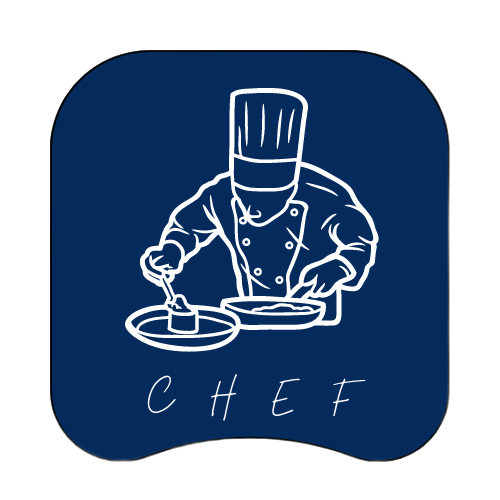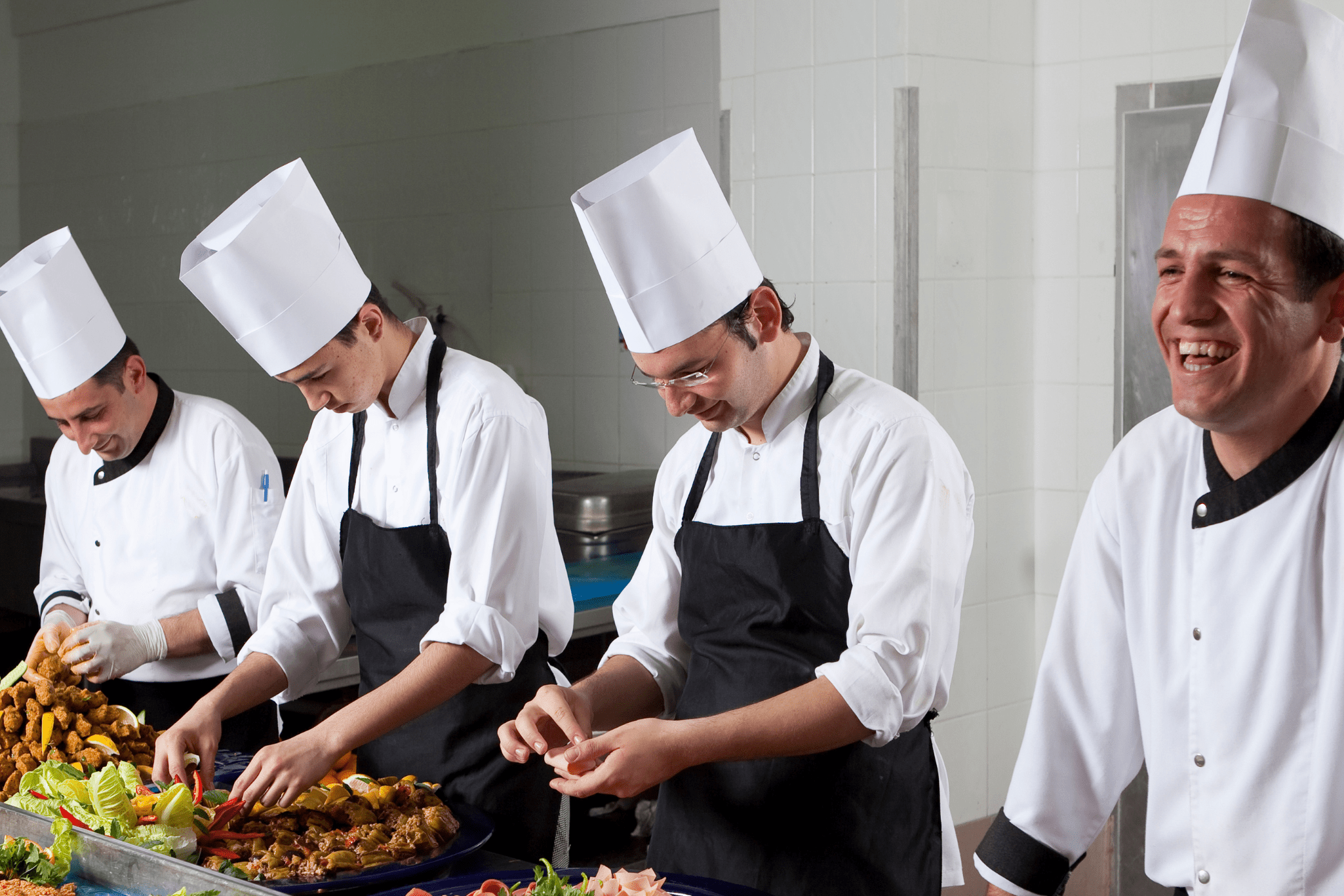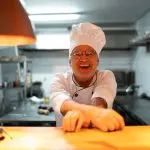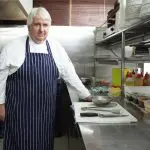Chef hats, or toques, have a long history and are steeped in symbolism. The tall, conical shape of the hat is believed to have originated in the 16th century in France. Where it was worn by chefs to signify their profession and to keep their hair out of the food they were preparing.
Over time, the number of folds in a chef’s hat came to represent their rank or level of experience. For example, a chef with a hat that had 100 folds. Was considered more experienced than a chef with a hat that had only 50 folds.
In addition to representing a chef’s rank or experience, chef hats also serve practical purposes. Today, chef hats are worn by culinary professionals in restaurants, hotels, and other food service settings around the world. They are made of a variety of materials, including cotton, polyester, and paper. And are available in a range of sizes and styles.
The Chef Hat: 16 Types and Styles Compared
Chefs have been wearing hats since the 16th century. While the traditional stiff and tall white toque chef hat has largely gone out of style. Chefs certainly aren’t short of choice.
Want To Skip Ahead?
- Tall Toque
- Modern Toque
- Beanie Chef Hat
- Skull Caps
- Bandanas
- Headwrap
- Baseball Caps
- Chef Visor
- Chef Beret
- Flat Caps
- Duckbill Cap
- Catering Chef Hat
- Chef’s Turban
- Chef Captain’s Hat
- Hair Nets
- Disposable Cook’s Hat
- Best Chef Hats for Long Hair
- How to Wear a Chef Hat
- Why Are Chef Hats Tall
- Where Did Chef Hats Come From
- Chef Hat History And Symbolism
- Chef Hat Care And Maintenance
While the exact origin of the chef hat is debated (some believe it was to stop condensation and grease. From dropping onto their heads in non-ventilated kitchens. And others believe it was after Henry VIII had a chef beheaded for a hair in his soup). Hats nowadays are lightweight and designed to keep hair contained.
If you’re trying to decide what type of hat to wear at work, you’re in the right place. Read on as we discuss 16 types of chef hats, their pros and cons, and who they’re best for.
16 Types of Chef Hats Compared
Tall Toque
The tall toque is the kind of hat people will describe. If you ask them what a chef’s hat looks like. They’re tall and stiff, with a “poof” high above the head that provides ventilation. These hats are commonly worn in premium establishments by higher-ranking chefs.
Pros: Many nowadays are made from paper and so are lightweight and breathable. You can recycle them after each use.
Cons: The only real downside to these hats is that they are so tall. That anyone over 6 feet will find that it gets knocked off their head while walking through doorways or leaning into fridges.
Modern Toque
Traditionally, toques were tall and stiff as discussed above, but modern versions are much more comfortable. Toques still have a relatively stiff (yet comfortable) band around the top of the head. And then the top of the hat flops a little to one side, a little like a poofy beret. Many culinary schools require their students to wear this style of hat.
Pros: A stylish traditional hat that’s more usable than a tall toque.
Cons: Can be quite a lot of fabric if not made from paper.
Beanie Chef Hats
When you think of a beanie, you likely think of a knitted cap people wear in winter. However, chef’s beanies are quite different. Instead of flopping back behind the head, or coming down below the ears. Chef’s beanies offer a tight-fitting hat that is usually made of cloth but is sometimes made from paper.
Pros: Most beanies have elastic in the lining at the back of the hat. But some use a tie so you can adjust the fit to what is most comfortable for you.
Cons: Very close-fitting beanies may not be breathable enough to keep you comfortable.
Skull Caps
Skull caps (sometimes called pill box caps) are similar to a beanie hat, but with a little more structure. They hug the head but have a flat top, which gives a tidy appearance.
This is a good option for chefs who don’t have a lot of hair to keep out of the way. You can also find skull caps with a mesh top. Which is a good option for those with thick hair or who simply get hot at work.
Pros: Stylish and lightweight.
Cons: Make sure it fits correctly, otherwise you may find it comes off easily.
Bandanas
Bandanas are the most flexible option on the list, both in style and how you can wear them. The different patterns available are endless. And you can use them as a headscarf, headband, hair tie, or sweatband over the forehead. While most chef hats will soak up some sweat, a bandana is a good option if you sweat a lot.
Pros: You can keep a few in rotation and easily throw them in the wash after each use. Without worrying about them losing shape. You can try a few different styles and switch it up depending on the season. Another benefit of a bandana is you can tie it easily around your wrist when not in use.
Cons: Tying a bandana is a skill you’ll need to learn. Needs washing after every use.
Headwrap
A head-wrap is much like a bandana but comes with an elasticated front. And some stitching to form a head shape, so it is more form-fitting. Like a bandana, you tie it at the back of the head. This is a good option for more casual eateries.
Pros: Simple and easy to use.
Cons: Head-wraps are usually thicker than bandanas, and due to the closeness of the material. You may find wearing one a little too hot if you also have thick hair.
Baseball Caps
Looking for a stylish, comfortable, and casual option? A baseball cap keeps your hair out of your eyes and many are made with absorbent and breathable materials.
This is also a good option for anyone working in a kitchen with bright overhead lights or in an outdoor setting, such as a food truck.
Pros: Comfortable, casual, and easily accessible.
Cons: Their casual nature will make them unsuitable for many restaurants trying to cultivate a certain atmosphere. Make sure you wash them regularly.
Chef Visor
A visor is like a baseball cap but does not have fabric stretching over the head. Like a baseball cap, this is a good option for hot environments, casual eateries, and those cooking outdoors.
Pros: All the benefits of a baseball cap but with less fabric to trap in heat.
Cons: It can trap steam around the face if you’re not careful when opening lids. The lack of fabric around the head means you may need to wear it with a hair net.
Chef Beret
Similar to the modern toque hat, a chef beret has fabric above the head that flops over a little, but less so than a modern toque. They usually have small holes sewn into the upper fabric to provide some ventilation. This is a good choice for upscale restaurants.
Pros: Stylish and ideal for upscale restaurants.
Cons: A little big compared to other options, so it may take some getting used to.
Flat Caps
A flat cap is becoming more popular amongst chefs. Especially those in traditionally “British” environments where a flat cap can add to the atmosphere. These hats can be a little hot. So look for one with ventilation holes sewn into the sides of the hat.
Pros: Great for urban or quintessentially British eateries.
Cons: Can be hot, make sure it’s well-fitting or it may want to fall off as you work.
Duckbill Cap
This type of cap is like a backward flat cap. But it often has a slightly baggy fit compared to the streamlined look of a flat cap. These are popular in East Asian restaurants.
Pros: Looks stylish and keeps your forehead clear.
Cons: If it doesn’t fit well you may find you need to adjust it often.
Catering Chef Hats
Most commonly seen on school dinner ladies and in industrial kitchens. Catering hats are a trilby style that uses a flexible and lightweight mesh to keep the hair trapped inside. A small peak provides a little shade from harsh overhead lights.
Pros: Good option for people with a lot of hair they need to tuck under the hat.
Cons: They have a very identifiable style that won’t be appreciated in restaurants trying to present an upscale atmosphere. You can find some styles with pleated fronts that are more appropriate (often called a “bouffant cap”).
Chef’s Turban
A chef’s turban is much like a head-wrap but uses minimal fabric which is often stretchy, designed to trap hair close to the scalp.
Pros: Lightweight and keeps all hair out of your face, meaning you won’t have to readjust it throughout the workday.
Cons: If you have a lot of hair you may have to try a few to find one that holds your hair without slipping back.
Chef Captain’s Hat
A nod to 90s and 00s fashion, the chef captain’s hat is like a sailor’s hat but has a snug, sometimes slouchy fit. Make sure you find one that has good structure to it, or it can look messy.
Pros: Sits on top of the head, leaving much of your head free to breathe.
Cons: Try to find one that’s designed for chefs or it will have padding in the top of the hat that may make it unbearable to wear in a hot kitchen.
Hair Nets
Hair nets can be used alone or in combination with one of the other options on this list. The nets are often a requirement for any chef with long hair. Although some kitchens will allow you to braid it back out of your face. Hair nets are small, easy to store, and don’t require washing in between uses.
Pros: Cheap, won’t make your head hot, effective, does not need washing, and easy to store.
Cons: Can be uncomfortable under a hat, and become ineffective once stretched out. They aren’t very stylish, especially when used alone.
Disposable Cook’s Hat
Disposable paper hats come in a range of styles we’ve discussed above, including toque, beanie, and cap. These are often recyclable and are a good option if you don’t want to keep watching your headwear.
While all these hats come in traditional white, most also come in other colours and patterns, so you can add a little of your own style to your uniform.
Best Chef Hats for Long Hair
You can make almost any style of chef hat work with long hair provided you style it right first. Learn how to braid your hair and use hair slides to keep loose pieces from falling into your face. A hair net is also a good option.
If you wear a hairnet, any hat option can be a good one, but if you prefer not to wear a hairnet, look for hats that offer good coverage such as chef berets, bandanas (you can often tuck your hair up inside them), turbans, and caterer’s hats.
How to Wear a Chef Hat
Each hat has a slightly different way it should be worn, but regardless, you need to make sure it fits you correctly. Most chefs wear their hats either squarely on top of their heads or tilted back over the head.
Tilting it back slightly is a good way to keep your hair out of your face, make sure your forehead doesn’t overheat, and capture the hair on the back of your head. If you prefer this style, make sure your hat fits correctly (or can be adjusted) as you may find it slips back and needs rearranging often if it’s ill-fitting.
Whatever style you choose, make sure it’s comfortable, fits well, doesn’t make you too hot, and fits in with the style of your establishment.
Why Are Chef Hats Tall
Chef hats, also known as toques, are tall for a few reasons. One reason is to help keep the chef’s hair out of the food they are preparing. The tall, cylindrical shape of the hat creates a barrier around the head, preventing stray hairs from falling into the food.
Another reason for the tall shape of chef hats is to signify the rank or status of the chef wearing it. In professional kitchens, the height of a chef’s hat can indicate their level of experience or expertise. For example, a chef de cuisine, or head chef, may wear a taller hat than a sous chef, or assistant chef.
Finally, the tall shape of chef hats also serves a practical purpose by providing a place to tuck away towels, utensils, and other small items that a chef may need to access quickly while working in the kitchen.
Where Did Chef Hats Come From
The origins of chef hats, or toques, can be traced back to the 16th century in France. At that time, chefs wore tall, conical hats made of wool or linen to signify their profession. The hats were also used to help keep the chefs’ hair out of the food they were preparing.
As the culinary arts developed and professional kitchens became more organised, the tall, conical shape of chef hats became standardised.
Today, chef hats are made of a variety of materials, including cotton, polyester and paper. And are available in a range of sizes and styles. They are worn by chefs and other culinary professionals in restaurants, hotels, and other food service settings around the world.
What Are Traditional Chef Hats Called
Chef hats are called toques. A toque is a type of hat that is traditionally worn by chefs. The hat is tall and cylindrical, and it is typically made of white fabric.
It is worn to cover the chef’s head and to keep their hair out of the food. The toque is an important part of a chef’s uniform. And it is often seen as a symbol of their profession.
Chef Hat Care And Maintenance
Proper care and maintenance of chef hats can help extend their lifespan and keep them looking clean and presentable. Here are a few tips for taking care of your chef hat:
Wash your chef hat regularly to remove any stains or odor’s. Most chef hats can be machine washed, but you may want to use a gentle cycle and avoid using bleach or fabric softener
If your chef hat is made of a material that is prone to wrinkling, you may want to iron it on a low heat setting to remove any wrinkles or creases.
If your chef hat has become:
- Misshapen or lost its shape, you can try steaming it or using a hair dryer on a low heat setting to reshape it.
- Discoloured or faded, you may need to replace it. Over time, the fabric of chef hats can become worn and may no longer be presentable.
By following these tips, you can help keep your chef hat clean and in good condition, and ensure that it looks professional and presentable when you’re working in the kitchen.



















